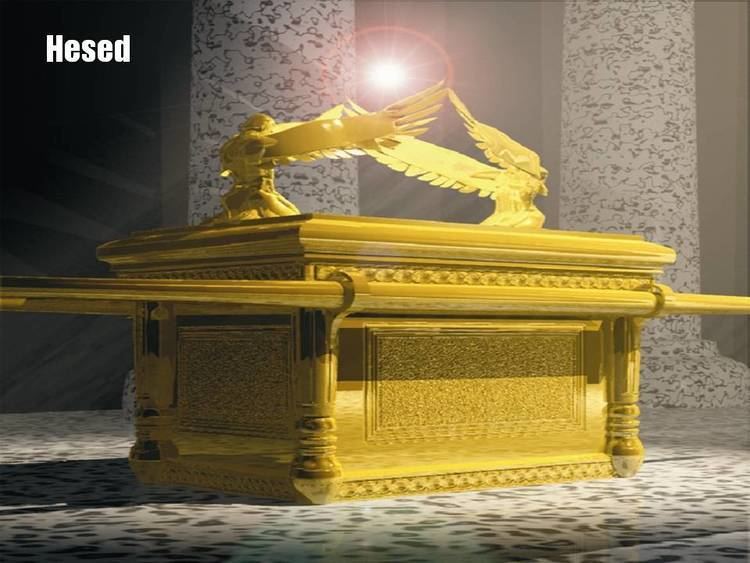 | ||
Similar Ark of bulrushes, Aaron's rod, Ark of the Covenant | ||
According to the Hebrew Bible, the mercy seat (Hebrew: הַכַּפֹּֽרֶת ha-kappōreṯ) was the gold lid with two cherubim beaten out of the ends of it to form a covering over this gold lid and placed on The Ark of the Covenant. This was connected with the rituals of the Day of atonement; where God did appear. The term also appears in later Jewish sources, and twice in the New Testament, from where it has significance in Christian theology.
Contents
- Mercy seat
- Etymology
- In the Hebrew Bible
- In Rabbinical tradition
- In the New Testament
- In Christian tradition
- References

The English phrase mercy seat is a translation of the Hebrew kapporeth (in the Masoretic text) and Greek ἱλαστήριον (hilasterion; in the Septuagint) by William Tyndale influenced by the German word Gnadenstuhl as in the Luther Bible; Gnadenstuhl, literally meaning seat of grace.
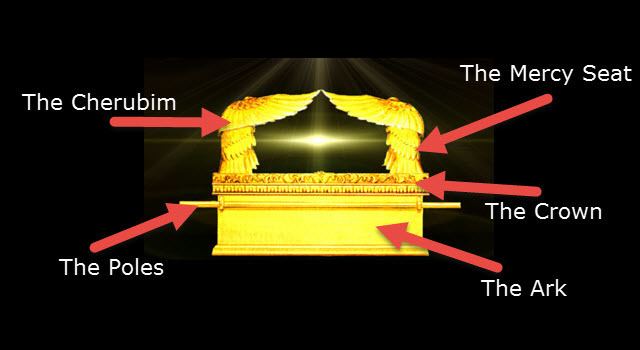
Mercy seat
Etymology
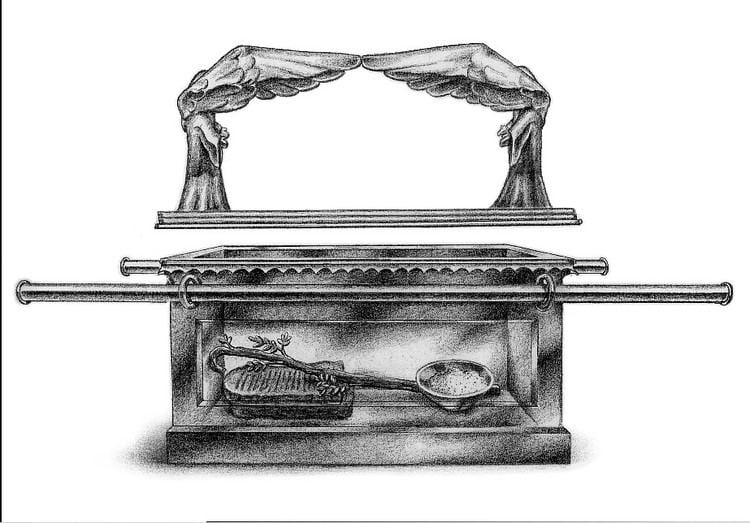
Though kapporeth is probably derived from kaphar, which is often considered to mean cover, the literal meaning of kaphar is wipe out, implying that kapporeth means thing of wiping out/thing of cleansing. The cognate Arabic term كَفَرَتْ kaffarat (also generally taken to mean cover, but from which the word kafir also derives) is used in modern legal contexts to refer to any mechanism of rectifying illegality (ranging from rectifying the failure to fast during Ramadan to the rectification of murder), for example the freeing of a slave after the slave has suffered shocking circumstances could be considered as a kaffarat. Similarly, hilasterion etymologically means thing for propitiation, with Hesychius writing that a synonym of hilasterion was thing for catharsis, while the Vulgate translates it as propitiatorium. Thus it is unclear whether the kapporeth was the lid of the Ark, or merely sat on top of the Ark, possibly with the Ark having a cover beneath it.
In the Hebrew Bible
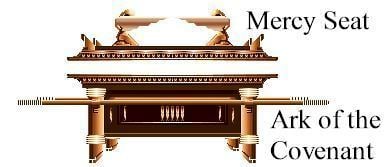
The Hebrew term "covering" (כַּפֹּרֶת kapporeth) occurs 27 times in the Masoretic Text of the Hebrew Bible, all of them relating to this particular item on the Ark of the Covenant. Jewish translations traditionally avoid the translation "mercy seat" as a later Christian gloss:
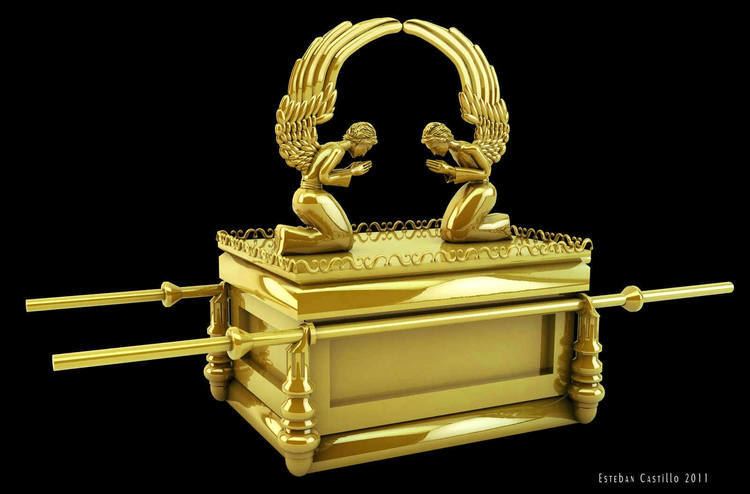
Exodus 25:17 And thou shalt make an ark-cover of pure gold: two cubits and a half shall be the length thereof, and a cubit and a half the breadth thereof. JPS 1917
Exodus 25:17 You shall make a cover of pure gold, two and a half cubits long and a cubit and a half wide. NJPS 1985
According to the biblical account (Exodus 25:19; 37:6), the cover was manufactured from pure gold, and was the same width and breadth as the Ark beneath it – 2.5 cubits long, and 1.5 cubits wide; the Ark and cover were, according to this passage, kept inside the Holy of Holies – the temple's innermost sanctuary, which was separated from the remainder of the temple by a thick curtain (parochet), because the ark and mercy seat were associated with the presence of Yahweh. The account also states that two golden statues of cherubim were placed at each end of the cover, facing one another and the cover, with their wings spread in order to enclose the cover (Exodus 25:18-21); according to the Books of Samuel, these cherubim together formed a seat for Yahweh (1 Samuel 4:4). Although a literal interpretation of the Book of Exodus would conclude that the mercy seat, along with the remainder of the Ark, was constructed according to the commands of Yahweh at the time of Moses, textual scholars regard the passages referring to its construction as originating from the priestly source, which they date to the 7th century BC.
According to the biblical directions, the Holy of Holies could only be entered on the Day of Atonement, and even then could only be entered by the Jewish High Priest, who was covenanted to do so in order to sprinkle the blood of a sacrificial bull onto the mercy seat, as an atonement for himself and his family, the other priests, the Tabernacle, and the people of Israel; the directions specify that incense was first burnt in the Holy of Holies so that a cloud rose up and appeared above the cover of the Ark. Some biblical scholars regard this ritual as an evolution from the simpler sin offering for the first day of the seventh month, given in the book of Ezekiel (Ezekiel 45:18-20); though the Masoretic Text renders this as the seventh day of the month, the Septuagint has ... first day of the seventh month, and scholars think that the sin offering on this day exchanged days with Rosh Hashanah, which in Ezekiel's day appears to have been celebrated on the tenth of the month (Ezekiel 40:1).
In Rabbinical tradition
In rabbinical tradition the original kaporet in the Tabernacle and Temple in Jerusalem is identified as a lid of pure gold on top of the Ark, and the name kaporet given since it served to "atone" (kaper) for the sins of the people.
After the destruction of the Second Temple, just as the Torah scroll was contained in an Torah ark (Aron Kodesh, "Holy ark") in synagogues so also the term kaporet was applied to the valance of the parochet (Hebrew: פרוכת "curtain") on this ark.
In the New Testament
The Septuagint term hilasterion appears thrice in the Greek text of the New Testament: Romans 3:25, and Hebrews 9:5, and 1 John 4:10.
Though the term mercy seat usually appears as the English translation for the Greek term hilasterion in the Epistle to the Hebrews, most translations are usually inconsistent as they instead generally translate hilasterion as propitiation where it occurs in the Epistle to the Romans. The Epistle to the Hebrews recounts the description of the Ark, Holy of Holies, and mercy seat, and then goes on to portray the role of the mercy seat during Yom Kippur as a prefiguration of the Passion of Christ, which it argues was a greater atonement, and formed a New Covenant (Hebrews 9:3-15); the text continues by stating that the Yom Kippur ritual was merely a shadow of things to come (Hebrews 10:1). The continual sacrifice for sin became obsolete once Jesus had died. This is the whole thrust of Hebrews ch 10, but is especially clearly stated in v11-14. The Epistle to the Romans states that Jesus was sent by God as a propitiation (Romans 3:25), while, perhaps in a reflection on Ezekiel's atonement ceremony, the Second Epistle to the Corinthians argues that Jesus had become a sin offering (2 Corinthians 5:21).
In Christian tradition
The first English Bible, translated from Latin 1382, renders the term "a propiciatory" following the Vulgate propitiatorium, and in the first occurrence, Exodus 25:17, also inserts an unbracketed gloss "that is a table hiling the ark" - "hiling" is Middle English for "covering":
Exodus 25:17 And thou schalt make a propiciatorie of clenneste gold; that is a table hilinge the arke; the lengthe therof schal holde twei cubitis and an half, the broodnesse schal holde a cubit and half. Wycliffe 1382
The term "propritiatory" was also used by J.M. Powis Smith, a Protestant, in The Complete Bible: An American Translation, published in 1939. The originally Protestant translation "mercy seat" was not followed by Ronald Knox, but has since been largely adopted also by Roman Catholic Bible versions, such as the New Jerusalem Bible (NJB) 1985
